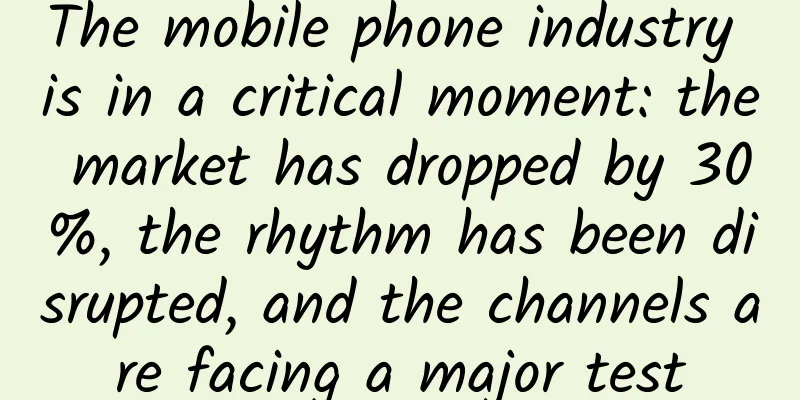The mobile phone industry is in a critical moment: the market has dropped by 30%, the rhythm has been disrupted, and the channels are facing a major test

|
After much hesitation among mobile phone manufacturers, the annual industry event MWC was finally cancelled. The staff who had previously announced that they would attend the exhibition and had been quarantined in Spain for several days also had to return. Although the risk of infection from crowds is avoided, this is not good news for mobile phone manufacturers: not only do they face losses in exhibition fees and exhibition costs, but their original product launch plans have also been disrupted, which will undoubtedly have an adverse impact on subsequent product sales. This is just one of the difficulties faced by the mobile phone industry under the COVID-19 epidemic. Due to the delay in the resumption of work in the supply chain and manufacturing factories, the production capacity of new products will face huge challenges; for the sales side, the customer flow in offline channels has also dropped sharply. All these have brought many variables to 2020, the year when 5G mobile phones will be popularized.
MWC cancels press conference and broadcasts online Xiao Li (pseudonym) is a media practitioner. His plan after the Spring Festival was to follow the manufacturers to the MWC exhibition held in Spain, but the new coronavirus epidemic disrupted everything. During the Spring Festival holiday, the number of confirmed cases in China continued to rise, and many countries also began to report cases of infection. For safety reasons, manufacturers such as LG, ZTE, TCL, and vivo announced their withdrawal from MWC. At this time, he began to worry whether the business trip could be carried out, but the manufacturer he followed continued to participate in the exhibition considering the early publicity, exhibition material investment, product release plan, etc. The organizers of MWC were also struggling. They first announced that the conference would be held as scheduled and announced a series of measures, including prohibiting participants from Hubei, China, and requiring participants passing through China to show proof of having left China for 14 days. However, after many well-known technology companies announced their withdrawal, the official decided to cancel the conference. For Xiao Li, the biggest impact may be on his travel plans, but for mobile phone companies, the impact is much wider. As an annual grand event in the mobile phone industry, domestic mobile phone manufacturers have high hopes for it. Huawei originally planned to release its latest generation of foldable screen mobile phone Mate Xs, OPPO planned to release its annual flagship Find X2, and vivo planned to showcase its latest APEX concept phone. With the cancellation of MWC, these manufacturers' product release plans need to be readjusted, including time, location, and employee business trips. A manufacturer said that although he had been in self-isolation in Spain for nearly a week, he had to return after the official announcement of the cancellation of the conference. The organizer has not yet made a clear statement on the exhibition fees that have been paid. In fact, the COVID-19 outbreak has not only affected overseas release plans, but also disrupted the domestic product release rhythm of mobile phone manufacturers. Due to the insecurity of gathering of people, many manufacturers announced that they would change their product launch conferences from offline to online live broadcasts. Lei Jun attended the online press conference wearing a mask On February 8, Xiaomi announced that it would hold an online press conference at 2pm on February 13 to launch the Mi 10 series flagship smartphones. Lei Jun, chairman and CEO of Xiaomi, said frankly that "this is a difficult decision", and Lu Weibing, vice president of Xiaomi and president of Xiaomi China, also said that the originally planned offline press conference with 3,000 people was changed to a pure online live broadcast, which was very challenging for an annual flagship. The teams needed to make huge adjustments. People familiar with the matter said that due to the impact of the epidemic, Xiaomi had actually been discussing whether to adopt an online release before the Spring Festival, but there were always concerns. For example, how can ordinary consumers reach this press conference? How do they accept online releases? In the absence of audiences and media, how to control the rhythm of the speech? However, as more mobile phone manufacturers join in online live press conferences, their concerns are gradually being dispelled. On February 12, vivo also announced that iQOO 3 will be released online on February 25. Zeng Kunpeng, general manager of iQOO mobile phone product line, also admitted on Weibo that this press conference coincided with the epidemic, and for the safety of the team, it was changed to an online live broadcast, but it was not easy. Now business trips, equipment mobilization, and teamwork are all big challenges. In addition, there are reports that manufacturers such as Honor are also considering holding new product launch conferences via online live broadcasts. The resumption of work is delayed and production capacity and channels are facing a big test The mobile phone industry includes the upstream supply chain, midstream mobile phone manufacturers and downstream channel dealers. This epidemic has affected not only mobile phone manufacturers, but also upstream suppliers and downstream channel dealers. On January 27, the State Council announced the extension of the 2020 Spring Festival holiday to February 2, and normal work will resume on February 3; subsequently, Shanghai, Henan, Guangdong and other places announced, based on the notification of the State Council, that except for essential industries, all other enterprises will not resume work until after the Lantern Festival on the 15th day of the first lunar month, and the earliest time to resume work is after 24:00 on February 9; in addition, many cities also stipulate that outsiders returning to work need to self-isolate for 14 days first. The extended holiday and 14-day self-isolation regulations pose a considerable challenge to the upstream supply chain resuming production. Take the mobile phone OEM Foxconn as an example. According to media reports, Zhengzhou Foxconn once promised to start work on February 10, but the number of employees on duty on that day was only 10% of the total. Zhengzhou Foxconn will quarantine workers returning from outside Henan for 14 days, and workers returning from Henan Province will be quarantined for 7 days. Shenzhen Foxconn Factory Notice A notice posted by a Foxconn employee in Shenzhen shows that employees already in Shenzhen need to confirm their activity tracks and physical condition in Shenzhen for the past 14 days, and can only enter the factory after approval from the highest epidemic prevention supervisor. No new personnel are allowed to enter the factory without permission. Employees who have not returned to Shenzhen, if they receive a notice to come to Shenzhen, need to prove that they have been in Shenzhen and have been quarantined for more than 14 days before they can return to work. Many Foxconn employees said on social media that they have not yet received a notice to resume work. "Please give me a definite answer whether I can go to work or not." "When can I go to work? I have had enough of lying down!" OPPO Vice President Shen Yiren admitted on Weibo that this wave of epidemic will definitely have a significant impact on the production capacity of this wave of flagship phones. The supply in the early stage will be relatively tight, because if the production capacity of a certain link in the supply chain (even the packaging box) is affected, the production capacity of the entire machine will be affected. Not only in the supply chain production process, mobile phone manufacturers also face severe challenges in offline sales. Zeng Kunpeng, general manager of iQOO mobile phone product line, said that industries where people gather and people come into contact will be greatly affected by the epidemic, especially catering, entertainment, shopping malls, etc. This also includes the mobile phone industry, because the mobile phone industry is essentially a retail industry. Take Apple as an example. On February 1, Apple's official website announced that it would temporarily close its retail stores in mainland China from now until 24:00 on February 9. On February 8, Apple said it was working hard to reopen its corporate offices and contact centers during the week of February 10, and was preparing for the reopening of its retail stores, but did not provide a specific opening date. As of now, only a few retail stores in China have begun opening. The previously popular Huawei stores are now sparsely populated Sina Technology recently visited offline stores of Huawei, Xiaomi and other manufacturers in Beijing. First, the customer flow in the malls where the stores are located has obviously decreased significantly, and the store customer flow is even less, which is in sharp contrast to the customer flow in the normal period before the holiday; secondly, the store's own sales staff have not fully returned to work, and only a few people are on duty. Will shipments drop by more than 30% in the first quarter? Market research firm Strategy Analytics pointed out in a report that 70% of the world's smartphones are manufactured in China, and the epidemic will affect the global smartphone supply chain and manufacturing capacity. Delays in factory operations due to quarantine or travel restrictions will inevitably lead to a temporary shortage of labor supply. The report believes that the new coronavirus has caused severe challenges for leading Chinese manufacturers such as Huawei, OPPO, vivo and Xiaomi. Strategy Analytics predicts that Xiaomi, Huami, and OV will face the risk of falling demand in the Chinese domestic market in the first half of 2020, while overseas market expansion will also be affected by production capacity and travel bans. International brands such as Apple will also be troubled by insufficient production capacity and the risk of falling demand in the Chinese market. Another research organization, IDC, predicts that due to the impact of the epidemic, the domestic overall market in January and February will face a sharp decline of about 40% year-on-year. In March, if the epidemic is under stable control, the overall market will gradually enter a recovery period, but it will still be difficult to recover to the same period last year. In the first quarter, the domestic market is expected to experience a year-on-year decline of more than 30%. Lei Jun, chairman of Xiaomi, also held this view in an interview at the press conference on the 13th. He said that domestic mobile phone sales will drop sharply in the first quarter of this year, but he is optimistic about the second and third quarters and believes that there will be a retaliatory rebound. The impact of the epidemic on the industry as a whole will not be as great as imagined. Mobile phone manufacturers are also trying their best to reduce the impact of the epidemic. A Huawei offline dealer said that Huawei is increasing online sales training for dealers, and even trying to sell products through WeChat Moments and live broadcasts. While offline customer flow is decreasing, online business is expanding to mitigate the impact of the epidemic. Xiaomi Vice President Lu Weibing admitted in an interview that currently only 20%-30% of Xiaomi's offline stores are open, so the sales channel of Xiaomi 10 will be mainly online for the time being. Lei Jun also believes that although the epidemic has brought an impact on offline channels, it will be a huge boost to e-commerce. He also called on consumers to buy Xiaomi 10 from online channels such as Xiaomi Mall and JD.com. Conclusion After several consecutive years of declining domestic market capacity, mobile phone manufacturers had expected to usher in an explosion in 5G mobile phones in 2020, but encountered the black swan of COVID-19. There is no doubt that the domestic mobile phone sales in the first quarter of this year will be greatly affected by the epidemic, and the entire mobile phone industry will usher in a period of difficult times. However, as Lei Jun said, "Life can be affected by the epidemic, but we must not be defeated by the epidemic." With the self-help of many companies in the upstream industry chain, mobile phone manufacturers, and channel dealers, we expect the mobile phone industry to usher in a "retaliatory rebound" after the epidemic. |
<<: Me, a mobile phone driven crazy by remote work
>>: Galaxy Z Flip's "glass screen" doesn't seem as durable as Samsung claims
Recommend
Experience in attracting new customers through marketing activities
Many activities seem to have been done, and time ...
A perfect event planning solution cannot be without these elements!
Do you hope that the event will become a hit? Tha...
10 Mother’s Day copywriting ideas!
This Sunday, May 13th, is Mother’s Day . Are copy...
Avoid detours: advice for Java programmers with 1 to 5 years of experience
Today, I am going to share some practical informa...
Attract 150,000 fans in 10 days with 0 cost. It turns out that the AARRR model can be used in this way!
After reading many articles about the AARRR model...
Case analysis: Tips to improve user activity and retention!
If a product lacks a complete activity and retent...
Online influencers selling products will soon be eliminated, and street stalls are the new traffic entrance for short videos!
Why do we say that the online celebrity purchasin...
How to plan a marketing campaign that can create multiple values?
The World Cup craze has just passed, and problems...
How to create highly sticky products? Teach you 3 models
What is CLV? You must understand this word when m...
There are so many online advertising channels, how do you choose the platform that suits you?
Preface: Some of the friends who read this articl...
I made one million a year selling health products. Can I make money selling health products for the elderly?
I once attended a training course at a certain in...
Startup App, 4 Cold Start Methods from 0 to 1
When cold-starting , Internet products can be rou...
Learn SEO from Beginner to Mastery with Me HD electronic version (download from Baidu Netdisk)
Learn SEO with me from beginner to master is a ve...
How to conduct refined data operation analysis?
The degree of refinement of efficient operations ...
Query the price of joining Zhangbei Luggage Mini Program. How much is the price of joining Zhangbei Luggage Mini Program?
For entrepreneurs, although mini program developm...









